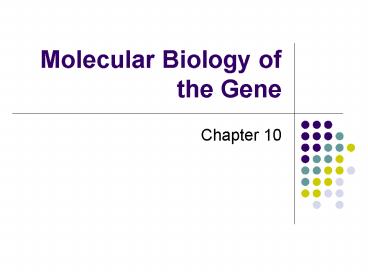Molecular Biology of the Gene - PowerPoint PPT Presentation
Title: Molecular Biology of the Gene
1
Molecular Biology of the Gene
- Chapter 10
2
- Viruses are biological saboteurs
- Hijacking the genetic material of host cells in
order to reproduce themselves - Viruses provided some of the earliest evidence
- That genes are made of DNA
3
Griffith Discovers Transformation
- 1928
- Attempting to develop a vaccine he isolated two
strains of pneumonia - Rough strain was harmless
- Smooth strain was pathogenic
4
Griffith Discovers Transformation
5
Transformation
- The harmless R cells had been transformed by
material from the dead S cells - Descendents of the transformed cells were also
pathogenic
6
10.1 Experiments showed that DNA is the genetic
material
- The Hershey-Chase experiment showed that certain
viruses reprogram host cells - To produce more viruses by injecting their DNA
7
Bacteriophages
- Viruses that infect bacteria
- Consist of protein and DNA
- Inject their hereditary material into bacteria
8
The Hershey-Chase experiment
9
10.2 DNA and RNA are polymers of nucleotides
- DNA is a nucleic acid
- Made of long chains of nucleotide monomers
10
DNA has four kinds of nitrogenous bases A, T, C,
and G
11
RNA is also a nucleic acid But has a slightly
different sugar And has U instead of T
12
DNA is a double-stranded helix
- James Watson and Francis Crick
- Worked out the three-dimensional structure of
DNA, based on work by Rosalind
13
Hydrogen bonds between bases Hold the strands
together Each base pairs with a complementary
partner A with T, and G with C
14
DNA Replication
- DNA replication depends on specific base pairing
- DNA replication
- Starts with the separation of DNA strands
- Then enzymes use each strand as a template
- To assemble new nucleotides into complementary
strands
15
DNA Replication
- DNA replication is a complex process
- Due in part to the fact that some of the helical
DNA molecule must untwist
16
DNA Replication
- DNA replication
- Begins at specific sites on the double helix
17
DNA Replication
- Each strand of the double helix
- Is oriented in the opposite direction
(antiparallel)
18
DNA Replication
- Using the enzyme DNA polymerase
- The cell synthesizes one daughter strand as a
continuous piece - The other strand is synthesized as a series of
short pieces - Which are then connected by the enzyme DNA ligase
19
DNA Replication































